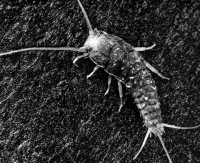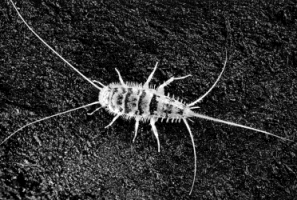
Consulting Entomologist

Tel/Fax: 01275 854224
E-Mail: [email protected]
Site Guide
Site Search
Home Page
Career Page
Insect Files
- Contents
- Bug Index
- The World of Bugs
- Classification of Bugs
- Insect Identification
- Insect Fossils
- Insect Body-parts
- Micro View of Bugs
- Insect Life Cycles
- Insect Defences
- Insects of Nailsea
- Pesticide Safety
- Bibliography
Shortcut to the main groups of insects and other arthropods...
Bug Rhymes & Poems
Links
Shop
Payments (credit/debit card)
Order Thysanura - Bristletails(Thysan-ura, from Greek thusanos = fringe, oura = tail) |
Class: Insecta Order: Thysanura | |
| Examples: | ||
|
Small insects with compound eyes and very long, thread-like antennae. Mouthparts for biting and chewing. Tarsi 2-4 segmented. Body often covered with scales. Abdomen with long cerci and a median tail filament. These processes are fringed with bristles. Metamorphosis is slight or wanting, with at least six nymphal stages and often many more. Many members of the Order continue to moult periodically throughout their adult lives. This is unusual because insects normally stop growing and moulting once they reach maturity. The Order contains about 600 known species, of which 23 are found in the British Isles. |
|
| |
| Silverfish - Lepisma saccharina | |
|
Description. Up to 10 mm long, covered with glossy, silver-coloured scales. Biology. A common insect which in temperate regions is nearly always associated with human habitation. It lives in dark, damp corners in pantries, storerooms, wardrobes, libraries and bookshelves, where it feeds on tiny bits of rubbish, dust, paper, cloth, leather, paste, flour, sugar and any other kinds of starchy material. Mainly nocturnal, so that its presence often goes unnoticed. The life cycle is fairly long, taking about 3 years to reach maturity - an adult may then go on to live well over 5 years. Distribution. Cosmopolitan inside buildings. Occurs outdoors in warmer regions. <<< TOP |
|
|
(classification of insects) |
(identification key to insect orders) |
| <<< TOP | (use the back button on your web browser to return to the previous page) | TOP >>> |

